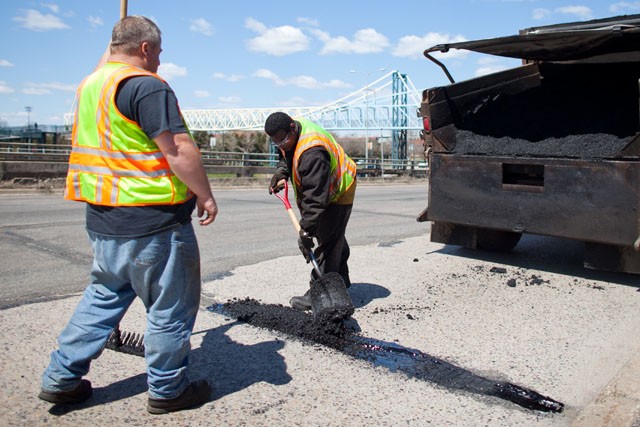After reflecting on the state of MinneapolisâÄô streets, Carol Greenwood simply laughed.
âÄúMediocre at best,âÄù she said pointedly.
After living in Minneapolis for 52 years, Greenwood said she has watched the number of potholes increase and the quality of roads deteriorate.
âÄúThereâÄôs a lot of spots where there are foot-wide potholes with 6 inches below, at least,âÄù Greenwood said. âÄú[It] can give quite the jolt on your transmission.âÄù
Roughly 35 percent of MinneapolisâÄô city-owned streets have been rated as below satisfactory and are in need of aggressive treatments, according to a Minnesota Daily analysis of a city streets database.
Acknowledging that the roads arenâÄôt at a level that they should be, Minneapolis Director of Transportation and Maintenance Mike Kennedy said budget cuts have made it difficult to keep up with needed repairs.
âÄúThe cuts get so deep that not only are we not doing repairs effectively, but we have fewer crews,âÄù Kennedy said.
The cityâÄôs budget comfortably supported 11 repair crews a decade ago but now supports seven, with extra crews serving only as needed. As a result, crews are slower on large arterial streets.
To make up for the lack of funding, the city has increasingly relied on short-term maintenance procedures. In the last 10 years, 77 percent of all maintenance was done with seal coating, the cheapest major treatment besides filling potholes. A seal coat extends road life by only five years compared to reconstruction efforts, which extend a roadâÄôs life by 20 years.
âÄúUnfortunately the first thing that goes with budget cuts is preventative maintenance,âÄù Kennedy said. âÄúIt makes no sense.âÄù
The city prioritizes street repair based on the amount of traffic, available funds and its pavement ratings. Needy but less-traveled roads wonâÄôt make it to the cityâÄôs agenda for years.
Potholes on the rise
Last year roughly 10,000 potholes were filled, Kennedy said. But in some neighborhoods, residents feel these repairs are grossly ineffective, such as the five residential blocks near 14th Avenue Southeast and East Hennepin Avenue in the Southeast Como neighborhood, where the city has never paved the streets.
The roads are made of oil-dirt, littered with foot-wide potholes and odd mixes of old patches with various materials.
âÄúIâÄôve traveled all over the world and these are some of the worst roads,âÄù resident Jeremiah Peterson said. Indicating the way streets were raised in the middle and sunken on the sides, he said, âÄúThe sides of the street donâÄôt look like anything youâÄôve ever seen.âÄù
In the cityâÄôs notes on the neighborhoodâÄôs potholes, city employees have inserted comments about the oil-dirt roads.
âÄúWeâÄôve patched this area two to three times since the first of the year,âÄù one said. âÄúAny repairs are temporary at best.âÄù
âÄúWe are doing what we can with what we have,âÄù another comment said. âÄúWith [the] budget getting cut, I am very ashamed of our streets.âÄù
SteveâÄôs Auto Repair Assistant Manager Jared Ruhl said he sees about one to two cars everyday with damage from potholes.
âÄúIâÄôve never seen potholes this bad âÄìâÄì this big, this amount,âÄù he said. âÄúEvery single road you go onto, youâÄôre going to hit one to two potholes.âÄù
Ruhl said he just spent $600 fixing his own car and needs to spend another $1,000 to repair his shocks.
Though some repairs are as cheap as $30, Ruhl said repairs of $1,000 are not uncommon.
This year the city has invested an additional $1 million in pothole repairs, which will help prevent rapid deterioration. The extra money will allow for twice as many repair crews to start work in the beginning of the summer.
Investing despite cuts
Roughly 62 percent of the cityâÄôs streets are at the end of their useful life, as most of the cityâÄôs streets were built in the 1960s and âÄô70s.
As these streets get older, the demand and extent of needed repairs only increases. Some older streets have aged so much that they need to be completely rebuilt.
The Accelerated Infrastructure Program, passed in 2008, has invested an additional $5 million per year until 2013 to help bridge that gap.
This year, 13 miles of city streets will be reconstructed in nine neighborhoods, which include Seward and Cedar-Riverside.
Of the roads already resurfaced, none had a pothole in it this year, Minneapolis Mayor R.T. Rybak said.
âÄúWhen we spend the money to fix it, it gets fixed,âÄù he said. âÄúBut we donâÄôt have nearly [enough] money to do that for all the streets.âÄù
Rybak said the city has underinvested in the roads for decades and now has âÄúa lot of catching up to do.âÄù
Being in the middle of a recession and facing âÄúmassiveâÄù cuts from the state government has made it difficult to invest in infrastructure, Rybak said, though it is his second highest priority next to public safety.
âÄúWe have a big problem,âÄù he said. âÄúWeâÄôve taken expensive steps and weâÄôre going to continue to do that unless we get massive cuts from the state.âÄù
Rybak said itâÄôs possible the state Legislature will cut more aid this year, which could prevent infrastructure renewal.
âÄúWe have a very large system that was built many years ago,âÄù University of Minnesota civil engineering professor Mihai Marasteanu said. âÄúRight now we are [at] the point in time where we need to invest to keep it at a reasonable level.âÄù
Marasteanu said he believed the city was doing the best it could given budget constraints, but repairs will only get more expensive in the future if there isnâÄôt enough maintenance now.
âÄúThis is a big issue,âÄù Marasteanu said. âÄúThereâÄôs a huge gap between what is needed and what is actually spent.âÄù
-Deepta Holalkere is a University of Minnesota journalism student.

Image by Anthony Kwan
Workers Bob Lucky, left, and Andre Johnson, right, fill a pothole with hot asphalt on Tuesday in Minneapolis.
Cuts could force Minneapolis to slow its assault on potholes
Officials say they need more funds to repair the miles of roads in disrepair.
Published May 4, 2011
0
More to Discover







